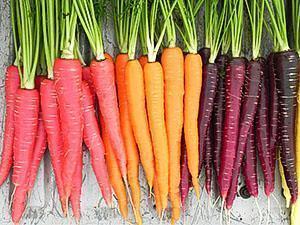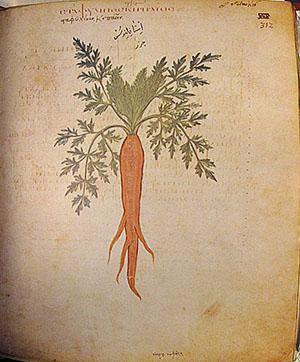The colorful history of carrots
 Carrots are one of the most important root crops for humans, grown in regions with a temperate climate. The vegetable cultivated today was derived from wild varieties whose roots were not orange at all. As the studies of scientists show, carrots were originally purple or yellow.
Carrots are one of the most important root crops for humans, grown in regions with a temperate climate. The vegetable cultivated today was derived from wild varieties whose roots were not orange at all. As the studies of scientists show, carrots were originally purple or yellow.
Today it is difficult to judge the origin and evolutionary paths of the existing 80 species of cultivated carrots. But archaeologists find carrot seeds during excavations along the entire coast of the Mediterranean Sea, in North Africa, in the Asian region and European countries with a temperate climate.
Wild species, most likely, initially for humans were not a source of juicy root crops, but greenery. Perhaps carrots were used and how medicinal plant.
Moreover, in Iran and Europe, the cultural layers, where evidence of carrot growth is found, are about 5 thousand years old. The fossil pollen of plants of the Apiaceae family belonging to the Eocene period has an age of 55 to 34 million years, which indicates the antiquity of the genus.
Ancestors of modern carrot varieties

The feathery leaves of the oriental type have a silvery shade and are noticeably pubescent. Such carrots are most widespread in Afghanistan, in the Himalayas and the Hindu Kush mountains, and in Iran, India and some regions of Russia. In the same territories, yellow carrots are also found, which in the wild are harder than dark-colored and have a pronounced pungent taste.
The beginning of the cultivation of purple carrots was probably in the 10th century. Three centuries later, purple roots appeared in the Mediterranean, and a little later they began to be grown in China and Japan. Eastern yellow and purple carrots are still grown in Asia, used to make a strong alcoholic beverage, but are inferior in popularity and distribution to Western varieties with orange roots.
The modern Western type of carrot is colored by carotene, so the roots can be red, orange, yellow or nearly white.
Most likely, such varieties were the result of hybridization and crossing of plants of the oriental type with wild subspecies of Mediterranean yellow carrots. Root crops consumed by Europeans, up to the 17th century, were thin, highly branched and not juicy at all.
The history of carrots in ancient times
 Archaeological evidence of the consumption of wild-growing carrots has been found at ancient sites in Switzerland.
Archaeological evidence of the consumption of wild-growing carrots has been found at ancient sites in Switzerland.
Temple paintings in Luxor, Egypt, dating from the second millennium BC, depict purple roots. And in the papyri found in one of the burials of the pharaoh, it is said about the treatment with the seeds of carrots or a plant similar to it. But neither archaeologists nor paleobotanists have yet been able to confirm the assumptions of Egyptologists about the distribution of purple carrots in the Nile Valley. Perhaps the ancient Egyptians were familiar with other members of the Apiaceae family, for example, anise, celery or coriander.
 Fossilized carrot seeds, at least five millennia old, have been found in the highlands of Iran and Afghanistan.
Fossilized carrot seeds, at least five millennia old, have been found in the highlands of Iran and Afghanistan.
Many varieties of a wide variety of colors have been found in Asia, and there is evidence of the use of wild carrots during the Hellenic period in Greece. Basically, the seeds of carrots and its rhizomes were used for medicinal purposes. For example, in the Ardennes during the time of Ancient Rome, carrots served as an aphrodisiac, and the Pontic king Mithridates VI believed that carrots could neutralize poisons.
 Dioscorides, who served as a physician in the Roman army, in his work De Materia Medica during his campaigns described and sketched more than 600 species of medicinal plants. The Byzantine edition of the work, dating back to 512, shows the reader the appearance of an orange carrot.
Dioscorides, who served as a physician in the Roman army, in his work De Materia Medica during his campaigns described and sketched more than 600 species of medicinal plants. The Byzantine edition of the work, dating back to 512, shows the reader the appearance of an orange carrot.
Documented history of carrots and their introduction into cultivation
 The first cultural plantings of purple and yellow carrots, according to confirmed sources, appeared in the 10th century in Afghanistan and Persia. At the same time, carrots with red root crops appear in Iran and in the north of the Arabian Peninsula.
The first cultural plantings of purple and yellow carrots, according to confirmed sources, appeared in the 10th century in Afghanistan and Persia. At the same time, carrots with red root crops appear in Iran and in the north of the Arabian Peninsula.- In the 11th century, yellow, red and purple carrot plants are grown in Syria and other North African regions.
- Through the Middle East and African countries in the XII century, carrots of the oriental type came to Moorish Spain.
- At the same time, the Asian type of plant reached China and Italy, where red carrots began to spread in the 12th century.
- In the XIV-XV centuries, red, yellow and white carrots began to be cultivated in Germany, France, England and the Netherlands.
- In Europe, thanks to crossing, already in the 17th century, an unprecedented orange carrot appeared.
- At the same time, orange and white root crops are delivered to South and North America, and in Japan they first develop the eastern, and a hundred years later, the western type of carrot.
White carrot riddle and classification issues
 In ancient Rome and Greece, carrots were called differently, which led to conflicting interpretations. In particular, under the name Pastinaca, both almost white carrots and light root vegetables of the parsnip, which was extremely popular at that time, could be hidden.
In ancient Rome and Greece, carrots were called differently, which led to conflicting interpretations. In particular, under the name Pastinaca, both almost white carrots and light root vegetables of the parsnip, which was extremely popular at that time, could be hidden.
Galen suggested giving the carrot the name Daucus, separating it from related species. This happened in the second century AD. In the same years, the Roman scientist Athenaeus proposed the name Carota, and the same root vegetable is called in the culinary book Apicius Czclius, dating back to 230.
However, with the fall of Rome, references to carrots from European written sources completely disappear. And the confusion in the identification of plants close in species and kinship continued until the Middle Ages, when purple and yellow roots were again brought to Europe from Asia.
Charlemagne issued a decree on the universal veneration of carrots and its recognition as the most valuable plant, and thanks to the openwork leaves and flower-umbrellas in history, carrots have become known as "Queen Anne's lace".
Today, the names of all varieties, from white root crops to black carrots, are subject to Linnaeus's classification, developed by him in 1753.
Start of carrot breeding
 Purposeful selection of the species began relatively recently. The description of the first cultivated variety dates back to 1721 and was carried out by Dutch botanists. Making carrots produce sweeter and larger rhizomes was easy. For the root crop to become noticeably straighter, sweeter and more juicy, the plant only needed good care and growing several generations in favorable conditions.
Purposeful selection of the species began relatively recently. The description of the first cultivated variety dates back to 1721 and was carried out by Dutch botanists. Making carrots produce sweeter and larger rhizomes was easy. For the root crop to become noticeably straighter, sweeter and more juicy, the plant only needed good care and growing several generations in favorable conditions.
Historians were surprised that less than three centuries passed from the moment the yellow and red carrot appeared in the Netherlands to its spread as a vegetable species, as if the plant itself wanted to be cultivated.
The most famous varieties, Nantes and Chantanne, are indebted to the French gardener-ascetic Louis de Villemorin, who in the 19th century laid the foundations of modern plant growing and in 1856 published a description of the varieties that are still in demand today.
Formation of carrot color
 Oriental yellow varieties became the basis for obtaining both orange and white carrots.This conclusion, after analyzing the gene pool of plants, was made by geneticists quite recently, but both yellow and red carrots continue to be cultivated in the world. A variety of purple carrots with a particularly intense dark color is called black. So what is the reason for such a variety of colors?
Oriental yellow varieties became the basis for obtaining both orange and white carrots.This conclusion, after analyzing the gene pool of plants, was made by geneticists quite recently, but both yellow and red carrots continue to be cultivated in the world. A variety of purple carrots with a particularly intense dark color is called black. So what is the reason for such a variety of colors?
The color of the carrot root is the result of the action of various pigments related to carotenoids.
 Α- and β-carotene are responsible for the orange and yellow color of the root vegetable, while β-carotene can account for up to half of the total carotenoid content in orange or yellow carrots.
Α- and β-carotene are responsible for the orange and yellow color of the root vegetable, while β-carotene can account for up to half of the total carotenoid content in orange or yellow carrots.- The color of red carrot roots is due to the presence of lycopene and xanthophylls.
- White roots have the lowest carotene content.
- In addition to carotene, purple and black carrots contain a lot of anthocyanins, which is expressed in a higher antioxidant capacity than other varieties of root vegetables.
In the process of selection, carrots have become larger and more juicy. It has lost some of its essential oils, but has acquired other health benefits, depending on the color and its intensity.